When I ask about the length of the human attention span, I receive answers that range from 8 seconds to 45 minutes, with some predictable stops along the way (30 seconds, or 7-10 minutes or 20 minutes are all popular choices). If these numbers are right, how does anybody make it through a feature-length movie, much less an extended director’s cut? There’s a movie theater near my house that shows an 11-hour Lord of the Rings marathon every holiday season. Knowing the length of your audience’s attention span could really influence how you design learning experiences, but how do we reconcile the difference between 8 seconds and 11 hours?
So, what’s the real capacity of our attention? As with most things, the answer is it depends. Attention is fundamentally a resource allocation problem; what and how much attention should we pay to the stimuli around us?
If you are building a learning environment and want to best leverage the attention of your audience, you should consider the following:
- How do memory and attention act as a filter?
- How do people manage attention as a finite resource?
- How does willpower impact attention?
- How is attention a social experience?
- What are the implications of attention for learning design?
Memory and Attention as a Filter
At any given time we are flooded with sensory inputs. Right now as I’m writing this article, I’m perceiving the sound of the heating system, the feel of the couch I’m sitting on, the temperature, the fact that my feet are a bit cold, the buzz of an email on my phone, the books on the bookshelf, the papers on the table, and the thought that maybe I should have gotten coffee before I settled in to get some writing done. And that is just a sliver of what is going on in my relatively quiet space. In busier environments like work or public spaces or the Internet, how do we decide what to pay attention to?
First, it might be useful to look at how memory enables attention. The best model for this is the Information Processing Model (see Figure 1), one of the primary memory models and a classic from your introduction to psychology textbook.

All the sensory stimuli coming in (sights, sounds, scents) go into sensory memory, where they’re held for a very brief time (at most a few seconds). There, sensory memory acts as a buffer that holds the information just long enough for you to decide whether or not it’s important enough to shift your focus.
Imagine driving to work in a busy city. How many cars might you see on an average commute? Dozens? Hundreds? Most of the cars are immediately discarded from sensory memory as unimportant. You “see” them but only in the most cursory way.
Some of the cars will make it to working memory (also called short-term memory). This form of memory lasts considerably longer: 20 seconds or so. The cars immediately adjacent to your car, for example, might be tracked in working memory as you wonder: Am I leaving enough following distance? Is there someone in my blind spot?
There is debate about the capacity of working memory, although it is commonly accepted that it typically contains 3-4 items and almost never more than 7 discreet items. The timeframe for working memory can be extended through continued interaction or rehearsal. For example, if you see a sign that indicates you need to get off at exit 42A, you can repeat that to yourself to keep it in working memory until you actually need the information.
Now, we are starting to see implications for the design of learning environments. For example, too many discreet items in a learning environment at once are likely to overwhelm working memory. The really important question is: What makes it to long-term memory? This is the goal of much learning design—to help people retain key information in their long-term memory.
Which cars were memorable?
- The Tesla with the funky racing stripes?
- The big white SUV that kept tailgating you?
- The silver Honda that was the same make and model as the car your ex-boyfriend/girlfriend drives?
- The car your neighbor drives, which you see every day when you are leaving home?
What characteristics caused these cars to be memorable? In all likelihood, they were:
- Unusual or surprising
- Provoking an emotional reaction
- Meaningful or relevant to you
- Something you had previous experience with
- Something you interacted with during the drive
- Something you had repeated exposure to
If a car didn’t meet any of these criteria, it’s extremely unlikely that you would remember it for more than a few seconds. This isn’t a brain dysfunction. Our brains are designed to forget things that don’t matter. The list of characteristics or criteria that caused certain cars to be memorable can be used as a checklist for learning materials. If you don’t have one or more of these bullet points in your learning design it is unlikely that people will retain the information you are presenting.
We’ve all seen this horrible slide design in some presentation or class (see Figure 2), right? A good speaker might be able to make the content relevant and interesting, but all too often this sort of material gets uploaded in online learning environments without any further context or explanation.
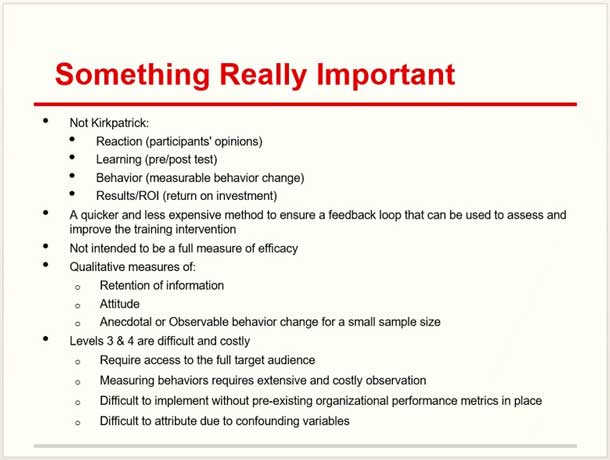
How does this slide compare against our list? Badly. The only way that someone will retain information from dense, context-less presentation slides like this is if the content is meaningful or relevant to them. This, however, is the one thing that the designer has the least control over.
Managing Attention: A Finite Resource
I sometimes describe instructional designers as the ruthless managers of cognitive load. It is their job to ensure that their learners’ cognitive capacity is being allocated in the right place. John Sweller’s cognitive load theory (see Figure 3) describes three main types of cognitive load: intrinsic, germane, and extraneous.
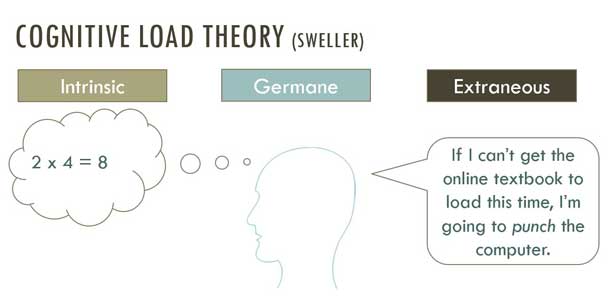
Intrinsic cognitive load represents inherent task complexity, germane cognitive load is the effort the user must exert to incorporate information, and extraneous cognitive load can be equated to noise in the system. The implications of this model on the design of learning environments are probably obvious: the more effort one must spend on extraneous load, the less capacity there will be for intrinsic and germane function. Additionally, the intrinsic cognitive load can’t be too high or the learner will be unable to process the information.
Allocation of attention
Immediacy is another variable that impacts the amount of effort required from the learner. If I ask you “On a scale of 1- 5, how interested are you in watching a video on printer repair right now (see Figure 4)?” you’d probably tell me your interest level is close to zero. If I were to make you watch the video regardless, it would probably be extremely difficult for you to allocate your attention to the video.
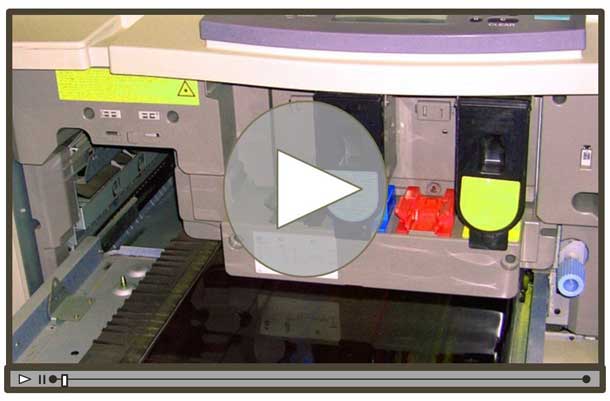
Now imagine your printer is broken and you need to print handouts for a crucial meeting that starts in one hour. You would likely find that same video much easier to pay attention to because you now have an immediate need to consume the information so that you can fix your printer. Even if the material is not produced in a polished or entertaining format, it’s not hard to allocate attention because it is urgent and relevant to you.
I often ask learning groups the following questions:
- Would you rather have $10 today or $11 tomorrow?
- Would you rather have $10 today or $11 in a year?
- Would you rather have $10 today or $1000 in a year?
Typically, the response to the first question is evenly mixed. In the second question, everybody wants the money now. In the third question, people are generally willing to wait for the significantly larger reward. Behavioral economists refer to this phenomenon as hyperbolic discounting, which essentially means that we prefer to get the reward now. And if we must wait for the reward, we discount its value (the drop-off falls in a hyperbolic curve, hence the name).
Most behaviors that humans have trouble with have an element of hyperbolic discounting. For example, a potential consequence of smoking is premature death, but it’s so far in the future that it’s discounted, and often the behavior does not change. Along the same line of thinking, the rewards for exercise, which requires expending a good deal of effort, can take weeks or months to show up, making it difficult to sustain the behavior.
So, how does this relate to learning? The main reward for learning something is getting to use it. The currency we expend to achieve that reward is effort and attention. I don’t think it’s a coincidence that we talk about paying attention. If we think back to the printer example, attention was not difficult to allocate when the knowledge could be applied to an immediate need. In the absence of a reward (or need) though, attention allocation would have been extremely difficult.
There are two obvious strategies that can be employed to address this. First, when possible, move the point of learning close to the point of use. Short informational videos are staples of just-in-time software training. A short video on how to assign a hyperlink to a button in Axure doesn’t need to be entertaining or engaging—it just needs to be clear and easy to find when a learner needs it.
Sometimes, however, it’s not possible to delay the point of learning. If, for example, you need someone to learn to recognize the symptoms of money laundering in financial transactions or to know how to evacuate a building in case of an earthquake, a just-in-time approach probably isn’t practical. In these cases, you can create the feeling of immediate need. For example, if you were in a class and somebody put a broken printer down on the desk in front of you and said, “Your task is to fix this printer and here’s a repair video for you to use for reference,” would that make it easier for you to pay attention to the video? For most people, it probably would.
Willpower and attention
In 1999, Professors Baba Shiv and Alexander Fedorikhin conducted an experiment. They divided participants into two groups and asked them to memorize sequences of numbers. The first group had to memorize two-digit numbers (a relatively simple cognitive task); the second group had to memorize seven-digit numbers (a significantly more difficult cognitive task).
Next, they offered participants a snack. Participants could have either a healthy fruit salad or an indulgent piece of chocolate cake (see Figure 5). Participants that were given the cognitively more challenging task took the chocolate cake almost twice as often as the participants in the easy condition.

This study, along with research by Roy Baumeister at Florida State University and Kathleen Vohs at the University of Minnesota, suggests that willpower is an exhaustible resource and that when it’s depleted, people are less able to exert it until their batteries have recharged, so to speak. By exerting willpower to concentrate on the harder memorization task, participants had less willpower to make good nutritional choices.
A typical brain represents approximately 2-3 percent of a person’s body weight, but uses close to 20 percent of blood glucose, our primary energy source.Concentrating uses a lot of resources. You can force yourself to pay attention to anything, but you pay a price for conscious focus of attention to material that you have no compelling interest in. It’s probably easier for most people to watch the Hobbits’ journey to Mordor than to do their taxes, but they can force themselves to focus on their 1040 forms if they have to. The question is, how long can they maintain that focus?
Attention is a Social Experience
The fact that people pay attention to other people’s faces is well documented in research literature. There may even be a specific brain region dedicated to it. People pay more attention to faces in photographs than to other stimuli, and also tend to look where other people are looking, which helps determine where and how people allocate attention.
Research by Sandra Okita, Jeremy Bailenson, and Daniel Schwartz at MIT in 2008 found that the mere perception of social interaction impacts not only learners’ attention, but also their memory and retention of the learning material.
Okita et al. had learners put on virtual reality goggles to interact with a virtual science tutor. Half the participants were deliberately misled to believe they were interacting with a real person, while the other half knew they were interacting with a computer. Both groups received identical information from the same virtual tutor. However, participants that believed they were interacting with a real person showed more arousal, focused more on the tutor, did better on the post test, and retained more information overall.
Implications of Attention for Learning Design
Given what we know about attention, I use and recommend the following strategies for the design of learning environments to attract and retain learners’ attention:
- Make it immediately useful
- Reduce extraneous cognitive load
- Use emotion and stories
- Incorporate the cues that make material sticky
Make it immediately useful
If the learner has something specific that they want to use the learning material to do, your best option is to make the learning material easy to locate and get out of their way. But if the learner isn’t bringing their own motivation to the table, you should structure the learning experiences around authentic, achievable goals.
For example, if they didn’t already have a goal of their own, which of the following Photoshop classes would give beginners a concrete goal they can accomplish (see Figure 6)?
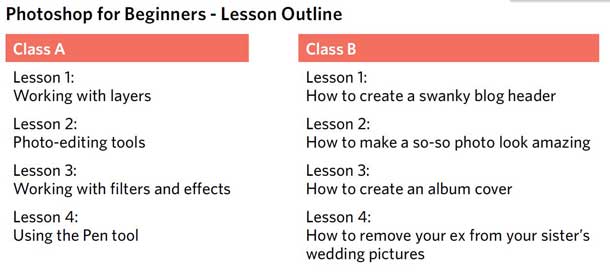
To create a sense of immediacy (where there is none), the problem needs to feel real. Take a look at the two screens below from a terrorism training course for California police officers (developed by Allen Interactions and used with their permission). (see Figure 7).
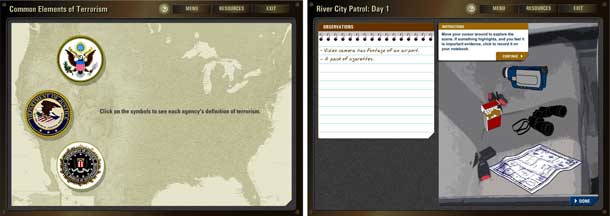
In the screen on the left, the user needs to click three different medallions to see three different legal definitions of terrorism. In the screen on the right, the user is looking at items on the inside of a car during a routine traffic stop. The objective is to identify items that seem significant and click to add them to the observation notebook. Both examples involve interactivity, and the gestures the user must perform are nearly identical (click an item to reveal relevant text). I’ve used a demo of this course with dozens of students in instructional design workshops, and they all report that it’s much easier to pay attention to the module on the right, which is grounded in an authentic situation.
Reduce extraneous cognitive load
It’s important for learners to be able to reserve as much cognitive capacity as possible for the actual learning content. Effort that is spent on extraneous tasks like logging in or navigation leaves less capacity for learning. Content can also impact cognitive capacity. Conversational content, for example, usually has a lower cognitive load than formal speech (see Figure 8).

Use emotion and stories
One of the cues that tell us something is important is our own emotional and physiological reaction. Insurance procedure information, often presented in a context-free and dispassionate format (see Figure 9 left), is likely to stream past like the dozens of cars we don’t pay any attention to on our daily commute. But with the right learning design, even something as dry as insurance training can use stories and emotion to attract and retain attention (See Figure 9 right):

Incorporate the cues that make material sticky
Create learning experiences that use some or all of the following:
- Make it unusual or surprising
- Use appropriate repetition
- Provoke an emotional reaction
- Make it meaningful or relevant to the learner
- Tie it to the learner’s prior experience
- Give them something to interact with
While involuntary attention can be grabbed by motion or a sudden flash, the kind of sustained voluntary attention that learning requires is supported by the nature of the learning materials and by the learner’s past experience with, and current need for, the learning materials.
Learners will pay attention to even the most poorly designed materials if their need is pressing enough, or if they already have enough context and experience to draw meaning from them. The feeling of need can also be created by presenting learners with immediate real world problems to solve. In all cases, reducing the cognitive load of extraneous interface elements gives learners more cognitive capacity for learning.
